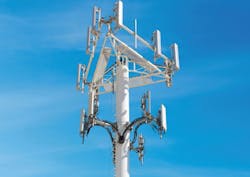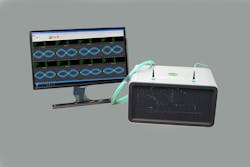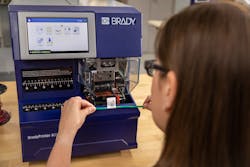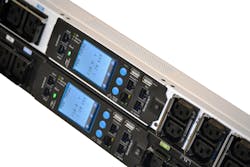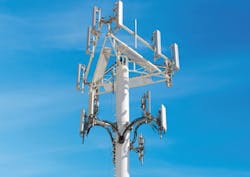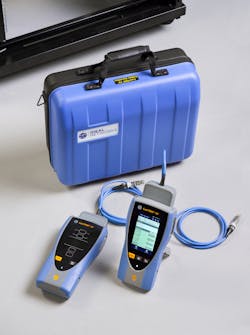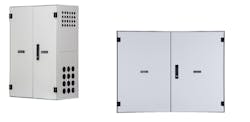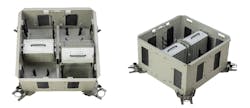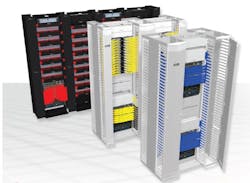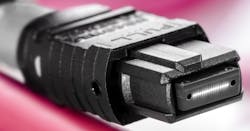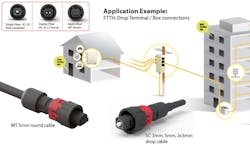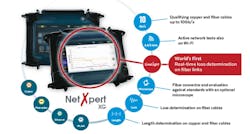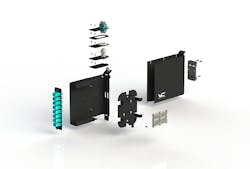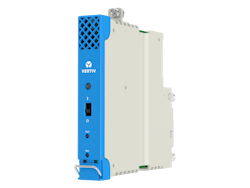Going for gold: Innovation excellence
Gold-level Cabling Innovators Awards are earned by organizations whose innovations are judged to be excellent, and whose benefits are clear. Each gold-level innovation makes a substantial improvement over previous methods employed, approaches taken, or products and systems used.
Following are the 18 honorees that received Gold level Cabling Innovators Awards.
The WideOptix measurement system from AEM offers a purpose-built eye-diagram based bandwidth verification system for multimode fiber-optic cables and components. Standards organizations such as TIA and ISO require certification testing of fiber-optic cables after installation. While the certification testing is necessary, its effect is limited to identifying light-blocking events along the fiber run. It does not confirm whether the fiber is good enough for the intended speed. WideOptix test system is designed to detect bandwidth limitations before deploying actual data services. With its fast testing and detailed and clear reporting, with pass/fail indication, WideOptix is an easy-to-operate test system. WideOptix-SR4 measurement system can be viewed as a sophisticated and purpose-built combination of a signal generator and an oscilloscope for extremely high-speed signals ranging in 25-GHz frequencies.
The 90S is the latest core-alignment splicer from Fujikura, and offered by AFL. It is designed to provide high-quality splices. The 90S kit solves common problems seem in the field today, from splicing poor quality legacy fiber to automated equipment maintenance and upkeep The 90S can be used in any field splicing application seen today: bend-insensitive fibers in drop cables, long-haul terrestrial and submarine LEAF fibers, loose buffer fiber, splice-on connectors and more. The 90S’s speed and accuracy make it suitable for certain production and specialty environments, where high output, tight packaging, and low-loss requirements are needed.
Belden developed a product that includes its highly flexible Category 6 SF/UTP Ethernet cable and industrial field attachable REVConnect RJ45 Plug. It ensures synchronized IP networking, faster installation, ease of use, and safe operation, Belden says. The cable is designed to meet up to 10 million flexing cycles that cover most critical scenarios in industrial automation. It is also highly ruggedized with excellent flame ratings and halogen-free property. These products were created for meeting the strict requirement of Ethernet cabling installation on the passenger boarding bridges at one of the world’s largest international airports in China. In collaboration with the airport authority, passenger bridge manufacturer, and system integrator, Belden initiated the development of the highly flexible Category 6 SF/UTP halogen-free PUR cable.
Brady’s A5500 Flag Printer Applicator tackles difficult flagging issues including consistent application, connectivity, and reduced waste. Brady says the A5500 is an efficient, labor-saving device that boosts production. Using software-driven automation, the BradyPrinter A5500 prints and flags wires and cables in 5 seconds. Other features include a 300-dpi printhead that prints barcodes, logos and text and applies cable flags that can communicate large amounts of information; the ability to identify cables from 0.06 inches to 0.6 inches in diameter; a 7-inch intuitive touchscreen; and Print Smart technology that allows the printer communicate with label and ribbon for faster setup and changeover.
eConnect Power Distribution Units (PDUs) are Chatsworth Products’ (CPI) answer to the growing demand for reliable, intelligent power distribution at the rack level. eConnect combines valuable features and integrates three hardware systems (power management, environmental monitoring and access control). This greatly lowers the cost of networking for remote monitoring at the rack level—one of the challenges for organizations that see value in data-driven power management. In 2020 CPI added several features to its eConnect line, including the following. 1) Phase-balance outlets on three-phase models to ensure equal loading across all phases. 2) The addition of field-replaceable controllers for easy serviceability and upgradeability while maintaining power to critical loads. 3) Switched eConnect models with bistable latching relays for reduced energy consumption and increased service reliability. 4) A newly patented locking outlet that not only prevents accidental disconnections, but also is easily accessible from the front of the PDU. 5) A Redundancy Pack to help easily identify the primary and secondary (failover) unit. The pack uses color coding to identify the A and B feed PDUs. 6) Outlet labels that are printed onto the PDU chassis, ensuring individual outlets, including high-outlet-density units, are labeled permanently and neatly. 7) The eConnect RFID Electronic Lock Kit, which uses a modular, integrated swinghandle and reader.
PowerShift 2000FA is the latest addition to CommScope’s PowerShift family of intelligent plug-and-play DC power supplies. In cellular networks, PowerShift regulates the voltage at the remote radio unit (RRU), keeping it at a constant -54 VDC on a steady basis without a tower-top converter. “Cell sites are steadily demanding more and more power at the top of the tower,” CommScope explains. “New radios, as well as those in development, need more energy to help meet the world’s insatiable thirst for more capacity and faster throughput. These radios, whether in an LTE network or a new 5G network with massive MIMO architecture, have raised the average wattage requirements per RRU from 100 to 300 watts at the turn of the century to 1 to 2 kilowatts today. Moreover, operators are installing more RRUs at the tower top than ever before.” Typically, thicker and heavier copper cables would be used to deliver power to these new RRUs. “What the industry needed was a way to keep using the same copper cables that were on a cell site, even as the radio’s power requirements increased,” CommScope further explained. “This would enable a simpler, less-expensive upgrade. It also would allow a company to standardize its cabling, deploying the same diameter cables across all sites, effectively lowering inventory costs.” The PowerShift 2000FA can supply up to 2000W per RRU in a one-rack chassis, supporting up to 4 RRUs per rack, with both ganged and front inputs to make connections easy in tight spaces. It also increases battery backup times by as much as 50%.
LanTEK IV is a copper and fiber cable certifier that provides a unique way to certify, bringing a new standard to the industry and enabling 7-second Category 6A test times. LanTEK IV includes the patent-pending VisiLINQ permanent link adapter, which Ideal Networks describes as “a unique way to test that gives users everything needed to initiate testing and view the results in the palm of their hand. This innovation helps technicians to work smarter, saving time and increasing productivity. The RJ45 tip on the VisiLINQ Permanent Link Modules are also field-replaceable to reduce cost of ownership.” LanTEK IV includes a Live Wiremap feature, which allows installers to instantly see a fault before the autotest even begins, so no time is wasted waiting for the test to complete. Time-domain reflectometry enables LanTEK IV to show an accurate distance to fault. The test platform incorporates the IDEAL AnyWARE cloud test management system, which allows real-time collaboration between project managers and technicians.
Leviton launched its Shuttered LC Cassettes and Adapter Plates in early 2020. The innovative shuttered feature is available in multiple Leviton patching platforms, including the HDX ultra-high-density system, e2XHD high-density system, and SDX standard density system, as well as individual QuickPort adapters. “The U.S.-made Leviton internal shutters provide unique benefits for network managers, to make network installation and maintenance easier, cleaner and safer,” Leviton explains. The shuttered LC components have an Ingress Protection (IP) rating of IP5x, which validates there is a tight seal around the shutter door that minimizes ingress of dust or other fine contaminants during manufacturing, assembly, shipping, installation and operation. Leviton had it shuttered cassettes, adapter plates, splice modules, and adapters undergo testing by an independent lab to confirm the IP5x rating for dust protection, per IEC 60529 standards. The samples were exposed to 8 hours of settling dust with a circulating fan, and all the Leviton shuttered LC adapters passed the inspection with no ingress of dust. The shuttered doors also provide front-facing highly visible B-A polarity identification. The internal shutters allow for easy visual fault locator traceability.
The HD Fusion Fiber Wall Mount Splice Enclosure from Panduit houses, organizes, manages and protects cable-to-cable fusion splice connections. It accommodates large-count fiber-optic cables typically coming in from outside the building, transitioning to smaller-count cables within the data center. This enclosure features splice trays that can accommodate individual or ribbon fiber and comes in two different sizes to splice up to 3456 fibers or 6912 fibers. The enclosure’s versatility makes it an ideal choice for a variety of applications including building entrance facilities/meet-me rooms, data centers, hyperscale, colocation, and telecommunications. Among the wall-mount enclosure’s benefits for users is the ability to pay-as-you-grow. Multiple enclosures can be ganged together either horizontally or vertically, so enclosures are added only when necessary. The tray can rotate, so it can be easily viewed even when fully populated. The door can be removed and installed without tools, and includes an integrated work surface that can store on the door when not in use.
The HD Flex Raised Floor Enclosure saves real estate by providing space below the raised floor to mount TIA 19-inch rack-mountable patch panels, thereby relieving congestion in racks and cabinets for installing network equipment. Panduit says the enclosure is an ideal data center and colocation solution as a consolidation point or zone distribution area (ZDA). For mainframes or storage area network applications, a ZDA can also save floor space by locating a termination point in a raised floor enclosure rather than in an adjacent cabinet. The raised floor enclosure is capable of accommodating field terminated or preterminated copper or fiber cassettes as a ZDA for rapid data center deployments and reconfigurations. The enclosure provides an efficient and cost-effective method to design and deploy structured cabling systems for open office architectures in any raised floor application.
Panduit’s PatchRunner 2 Cable Manager family was completed with the addition of the PatchRunner 2 Horizontal Cable Managers, which complement the PatchRunner 2 Vertical Cable Managers to deliver an optimized cable management experience. The product family provides value to users on several fronts, all of which impact the bottom line. For example, managers and doors are orderable as a single part number, and arrive preassembled, with the doors attached. This means fewer components to order, inventory and install, resulting in cost savings, and less packaging waste. The managers are robust and sturdy yet lightweight and easy to handle, so one person can install them with ease. Even vertical managers quickly attach with a couple bolts by a single installer. Added space within the managers and between fingers makes it easier and faster for technicians to complete moves, adds, and changes, thereby lowering labor costs. A significant value comes in optimizing space within the telecommunications room. The Enhanced Vertical Manager includes the ability to mount standard 19-inch accessories—including patch panels—within the cable manager, freeing up valuable rack real estate for other equipment.
Circuit integrity cables, required by code to ensure survivability of critical circuits in order to protect people and property in the event of a fire, have been available for nearly 20 years. But their design has not significantly changed in that time. Many fire-alarm and area-of-refuge systems require multipair cable constructions, but most traditional pathway survivability cable options have been limited to one-pair constructions. The DuraLIfe II multi-conductor Fire Rated Cable from Radix Wire & Cable changes the way circuit integrity cables are installed. “No more messing around with multiple one-pair cables,” Radix explains. “DuraLife multi-conductor can provide up to four pairs under one jacket. In free-air installations, DuraLife multi-conductor will provide a more orderly appearance and reduce labor time. For in-conduit systems, the cable not only allows for smaller conduits, but also more conductors within the conduit, thus providing economical savings and ease of installation.” The DuraLife II Multi-Conductor Fire Rated Cable is available in 18-AWG through 12-AWG in both shielded and non-shielded constructions.
Rosenberger OSI’s PreCONNECT SEDECIM is a parallel-optic system optimized for 400GBase-SR8. It uses the MTP/MPO16 connector system, which is the MDI of 400GBase-SR8 transceivers. The connector enables data transfer of 400 Gbits/sec via 8 parallel full-duplex transmission lanes of 50 Gbits/sec each with PAM4 coding (8x50G) over a range of up to 100 meters. One of PreCONNECT SEDECIM’s innovations is that the ferrule endfaces of the MTP/MPO 16-fiber multimode connector are 8-degree APC angularly polished. This angled polish enables the return loss to be significantly improved, to a minimum of 50 dB. “The APC 8-degree angled polish has so far only been used from the outset for singlemode MTP/MPO ferrule endfaces to achieve reliable return loss,” Rosenberger says. “In contrast to this, only the PC 0-degree straight polish was previously used for multimode MTP/MPO ferrule endfaces. Due to their PC 0-degree straight polish design, multimode MTP/MPO connectors were previously particularly susceptible to performance problems caused by dirt particles, which in the past often led to unreliable too low return-loss values. In recent years, this problem has become increasingly sever due to the sharp rise in application data rates. The introduction of reflection-sensitive PAM4 coding at 400GBase-SR8 and other multimode applications with serial lane speeds of 50 Gbits/sec has shown its full extent.”
Senko’s IP-9 connector series’ compact footprint helps make enclosure and terminal sizes smaller, the company says. “With the IP-9, you can double the port density in the same footprint without compromising performance. While the size is small, it still provides an IP-68 water and dust protection rating and mechanically withstands 50 pounds of pull force.” All Senko’s IP-9 connectors are equipped with the company’s safe lock feature, which prevents accidental disconnects. The IP-9 series is available for SC, SN, and MT configurations. “This enables IP-9 connectors to support multiple deployment scenarios with one footprint, such as single fiber SC for FTTH drop, dual fiber connection SN for wireless networks, or multifiber MT for drop terminal applications,” the company adds. “Wireline and wireless network convergence is a key trend in the market, and IP-9 is the most suitable connector for the job.”
LiveLight is the newest feature of Softing’s NetXpert XG. It is a trend plot of the dB loss across a fiber from tester to tester. “That’s dB loss from an SFP at one end of the fiber to the SFP on the other end of the cable,” Softing explains. “You will see the dB loss vs. time on a trend plot on the NetXpert XG in real time. As conditions change, such as effects due to moving a bad connector, you will see loss levels change on a real-time trend chart display.” When describing the common real-world scenarios that gave rise to LiveLight’s development, Softing says, “What if you are testing fiber, and you get an unacceptable loss measurement? Then you retake the measurement, and this time, magically, the reading is good. This is frustrating. Is it the test cables? Did I do something wrong? Could it be an intermittent problem? What if I need to test cables that move as machines move?” Instead of taking a single snapshot, LiveLight offers a continuous light-loss measurement and enables users to view the results continuously on a live streaming plot.
Located blocks from the U.S. Capitol building in the heart of Washington D.C., the new 430,000-square-foot Museum of the Bible was five years in the making from initial design work to its grand opening in November 2017. The building was originally constructed in 1922 as a refrigerated warehouse. The museum’s leadership and its partners—including Superior Essex and Legrand—have repurposed the 8-story brick building and transformed it into a technological spectacle that encompasses high-tech displays, theme-park-style interactive exhibits, expansive theaters, thousands of artifacts and attractive event spaces. These all work together to attract visitors from different countries and cultures to experience the bible’s impact on the modern world. The museum partnered with integrator S2N Technology Group LLC to review technology requirements and then design each exhibit’s low-voltage application. Manufacturing rep Network Products Inc. specified and supplied the cable necessary to connect these complex, networked AV systems. Superior Essex delivered the fiber and copper cabling solutions, and Legrand supplied cable management and connectivity in the telecom and AV equipment rooms. Throughout the fast-tracked construction schedule of just under 2 years, S2N worked with Superior Essex and Legrand to design and equip more than 20 telecom and AV rooms, which housed all the active equipment and termination components for every application connected by the structured cabling, as well as to each exhibit. By completion, the low-voltage installer Net100 Ltd. had spent more than 26,000 hours installing more than 735,000 feet of Superior Essex fiber and copper cables to provide data, voice, power and AV to more than 2200 devies throughout the museum.
The EZ-Mount DIN-Rail Cassette from Vertical Cable provides flexibility in application configurations and convenience in installation and service. Its modular design includes two standard components: a universal cassette that can be used to create multiple configurations, as well as a 35-mm DIN-rail-mountable bay that holds everything in place. The cassette’s modular design allows it to be placed in three different positions within the bay: 1) Full depth (operating position, in which the cassette is completely covered and protected by the bay); 2) Half depth (which allows the user to perform manipulations on the LGX adapter plate connections without removing the cassette from the bay); and 3) Zero depth (in which all cassette internal components can be accessed for servicing and adjustments). The half-depth and zero-depth positions allow quick and safe access to the cassette internal components without removing the mounting module from the bay or removing the bay from the DIN rail.
The Vertiv eSure C48/58-1000 Power Extend Converter economically boosts voltage up to -58 VDC to support increasing power needs of remote radio heads on cell towers. The compact device, which is small enough to fit in the palm of a hand, plugs into an existing DC distribution panel in the same position as a single-pole bullet circuit breaker, conserving usable space. Describing the technological circumstances that make the eSure C48/58-1000 Power Extend Converter a valuable innovation, Vertiv explains, “5G-friendly radios require more power at the top of cell towers. A voltage drop between the power system at the tower’s base and the radio at the top can trigger a shutdown of the remote radio head before the equipment provider’s backup battery fully discharges.” The eSure Power Extend Converter consumes 0 units of additional rack space. Multiple units can operate in parallel to support radios requiring up to 3 kW of input power. Vertiv has developed a calculator to help operators determine the number of converters required to power the radios at their site, and how to position the devices optimally in the distribution panel.
